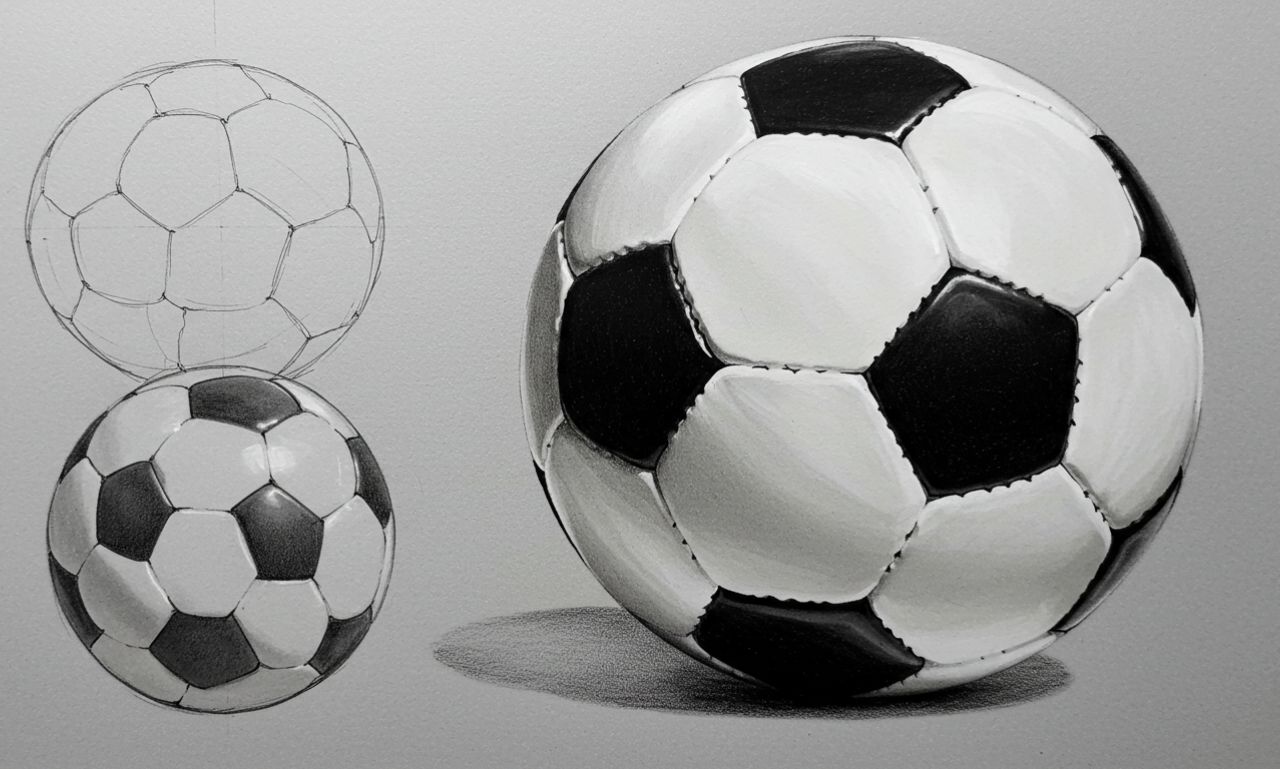Soccer ball drawing is a rewarding skill for artists, designers, and sports fans who want to create dynamic sports illustrations. Whether you’re sketching for a school project, designing sports logos, or enhancing digital artwork, knowing how to draw a soccer ball accurately adds authenticity to your work. In 2025, with sports design trending on social media and in graphic art, soccer ball drawing has become a popular skill to master.
Understanding the Structure of a Soccer Ball
Before you start drawing, it’s essential to understand what makes a soccer ball unique.
-
Shape: A sphere with a pattern of hexagons and pentagons.
-
Panels: Most traditional soccer balls have 32 panels—20 hexagons and 12 pentagons.
-
Symmetry: Panels are evenly distributed, creating a balanced appearance.
This geometric structure is key to making your drawing look realistic.
Tools You’ll Need for Soccer Ball Drawing
To achieve a clean and professional result, gather:
-
Pencils (HB for outlines, 2B for shading)
-
Eraser for refining lines
-
Compass for drawing circles
-
Ruler for measuring panel proportions
-
Fine-tip pens or markers for final inking
Digital artists can use drawing tablets and vector tools for precision.
Step 1: Drawing the Basic Circle
The foundation of a soccer drawing is a perfect circle.
-
Use a compass or trace around a circular object.
-
Keep the line light so it’s easy to adjust later.
-
Remember, slight imperfections can be corrected during inking.
Step 2: Marking the First Pentagon
The pentagon is the central reference point for your soccer ball.
-
Place it in the center of the circle.
-
Ensure each side is equal in length.
-
Draw lightly to avoid overcomplicating early stages.
Step 3: Adding the Hexagons
From each side of the pentagon, draw adjoining hexagons.
-
Maintain consistent side lengths.
-
Work outward evenly to preserve symmetry.
-
Adjust shapes slightly for the curved surface appearance.
Step 4: Filling the Ball with Panels
Continue adding alternating pentagons and hexagons until the sphere is filled.
-
Keep lines light until you’re satisfied with the layout.
-
The edges near the sides may appear narrower due to perspective.
Step 5: Outlining and Inking
Once your panel layout is complete:
-
Trace over lines with a fine-tip pen.
-
Vary line thickness for depth.
-
Erase pencil marks after the ink dries.
Step 6: Shading for Realism
Shading makes your soccer ball come alive.
-
Identify your light source.
-
Shade opposite areas for contrast.
-
Use smooth gradients for a spherical effect.
Step 7: Adding Highlights
Highlights make the drawing pop:
-
Leave small white areas for light reflections.
-
Use an eraser to gently lift graphite for subtle brightness.
Common Mistakes to Avoid in Soccer Ball Drawing
-
Misaligned Panels: Breaks symmetry and realism.
-
Flat Shading: Reduces the spherical illusion.
-
Over-darkening: Can hide details of the panel lines.
Digital Soccer Ball Drawing Tips
For digital artists:
-
Use vector shapes for perfect geometry.
-
Apply gradient fills for 3D effects.
-
Add texture overlays for a realistic leather look.
Creative Variations of Soccer Ball Drawing
Not all soccer balls follow the traditional black-and-white pattern.
-
Color Panels: Create vibrant versions for fun designs.
-
Custom Logos: Add team emblems in the central pentagon.
-
Stylized Shapes: Experiment with exaggerated patterns for cartoons.
Using Soccer Ball Drawing in Design Projects
A well-executed soccer ball can be used in:
-
Sports event posters
-
Merchandise and apparel
-
Digital sports game assets
-
Educational diagrams for physical education
Improving Your Soccer Ball Drawing Skills
Practice regularly with:
-
Speed sketches to improve hand coordination.
-
Studying real soccer balls for pattern accuracy.
-
Experimenting with lighting to master shading techniques.
Soccer Ball Drawing for Kids and Beginners
You can simplify the process for beginners:
-
Draw the circle.
-
Add fewer, larger panels.
-
Focus on bold outlines and minimal shading.
This makes the drawing less intimidating and more fun.
The Artistic Appeal of Soccer Ball Drawing in 2025
With the growing popularity of sports-themed art on social platforms, soccer ball drawing is becoming a favorite among content creators. Short tutorial videos showcasing step-by-step soccer ball illustrations attract large audiences, making it both an artistic and social media trend.
Conclusion
Soccer ball drawing is a rewarding skill that blends precision with creativity. Whether you’re aiming for photorealism or a stylized design, understanding the ball’s geometry, mastering shading, and adding personal touches will make your work stand out. In 2025, as sports art continues to trend in digital and traditional media, learning to draw a soccer ball offers both artistic satisfaction and practical applications.
With patience and practice, anyone can turn a simple circle into a detailed, eye-catching soccer ball illustration that captures the spirit of the game.

